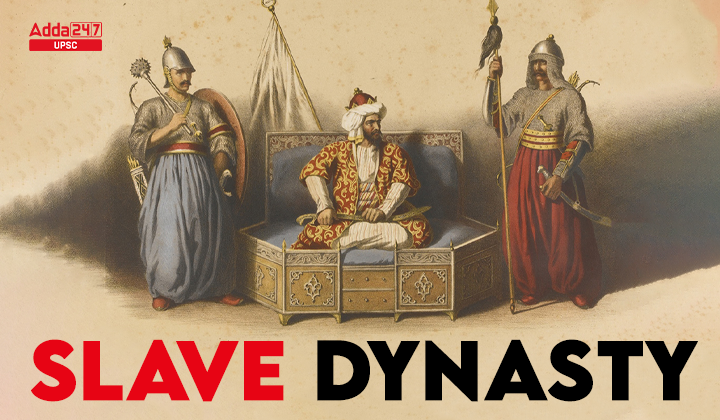Table of Contents
Slave Dynasty: Qutb ud-Din Aibak founded the Mamluk Dynasty, which governed Delhi in the 13th century CE. The focus of the dynasty was placed on Northern India by Qutb ud-Din Aibak. The Mamluks were a powerful military class made up of Muslims who were descendants of slaves.
Among the first dynasties to rule the Delhi Sultanate was this one. An important period in medieval Indian history, the Slave Dynasty, is covered in this article’s NCERT notes. It is advisable for aspiring IAS candidates to peruse the offered notes below for thorough preparation for both the prelims and main exams.
Slave Dynasty Origin and Founding
- The Mamluk Dynasty emerged in 1206 in the Delhi Sultanate.
- It was established by Qutb ud-Din Aibak, a Turkic Mamluk slave-general from Central Asia under the Ghurid Empire.
- Mamluks were converted Muslim slaves who became influential in various Muslim societies.
Qutb ud-Din Aibak’s Reign
- Qutb ud-Din Aibak, the first ruler, rose to power after his Ghurid overlord’s assassination.
- He laid the foundation for the Quwwat-ul-Islam mosque and the iconic Qutb Minar in Delhi.
- He extended control over North India and initiated the Delhi Sultanate.
Iltutmish and Consolidation
- Iltutmish, a Turkic slave, succeeded Aibak and moved the capital from Lahore to Delhi.
- His reign saw military successes against Mongol invasions and Rajput resistance.
- He introduced administrative reforms, and coinage, and expanded the territory.
Razia Sultana’s Rule
- Razia Sultana, Iltutmish’s daughter, was the first and only female Muslim ruler of Delhi.
- She ruled justly but faced opposition due to gender and association with Jamal-ud-Din Yaqut.
- Assassinated after marrying Malik Altunia, ending her brief reign.
Ghiyasudin Balban’s Iron Rule
- Balban’s rule (1266-1287) was marked by strict governance and nobility control.
- Introduced an efficient spy network, harsh punishments, and Persian cultural elements.
- Successfully repelled Mongol invasions and restored order in the empire.
List of Slave Dynasty Rulers
| Ruler | Reign |
| Qutb ud-Din Aibak | (1206-1210 AD) |
| Aram Shah | (1210-1211 AD) |
| Iltutmish | (1211-1236 AD) |
| Rukn-ud-din Feroze | (1236 AD) |
| Razia al-Din | (1236-1240 AD) |
| Muiz-ud-din Bahram | (1240-1242 AD) |
| Ala-ud-din Masud | (1242-1246 AD) |
| Nasiruddin Mahmud | (1246-1266 AD) |
| Ghiyas-ud-din Balban | (1266-1286 AD) |
| Muiz-ud-din Muhammad Qaiqabad | (1286-1290 AD) |
Architectural Advancements during the Slave Dynasty Era
Innovation and Flourishing
- The Slave Dynasty marked a period of architectural innovation and growth in India.
- Notable architectural marvels emerged during this era, leaving a lasting impact.
Qutb Minar and Quwwat-ul-Islam Mosque
- Qutb ud-Din Aibak initiated the construction of Qutb Minar in Delhi.
- The towering minaret showcases intricate designs and architectural brilliance.
- Quwwat-ul-Islam Mosque, adjacent to the minar, boasts intricate carvings and designs.
Structures by Iltutmish
- Iltutmish continued architectural advancements, further enriching the landscape.
- He built the Hauz-i-Shamsi reservoir and a madrasa around it.
- Iltutmish’s tomb, part of the Qutb Minar Complex, remains a testament to his legacy.
- Gandhak ki Baoli: The stepwell, Gandhak ki Baoli, constructed during this era, demonstrates water management skills.
- Mamluk rulers also built tombs, schools, monasteries, and other structures.
Balban’s Architectural Contributions
- Ghiyas ud din Balban, known for his strict rule, also left architectural marks.
- Construction activities aimed to establish order and grandeur.
Cultural Fusion and Influence
- Architecture during the Slave Dynasty period reflects a fusion of Turkic, Persian, and Indian styles.
- The blend of diverse architectural elements enriched India’s cultural tapestry.
Influence on Later Dynasties
- The architectural advancements of the Slave Dynasty laid the foundation for future dynasties.
- Subsequent rulers continued to build upon and expand the architectural legacy.
Cultural Aspects of the Slave Dynasty
Turkic Influence on Culture
- The Slave Dynasty introduced Turkic cultural elements to India.
- Turkic traditions, customs, and art merged with the Indian cultural landscape.
Language and Literature
- Persian, a language of administration, culture, and literature, gained prominence.
- Persian literature flourished, paving the way for rich literary traditions.
Religious Tolerance
- Despite being of Turkic origin, the rulers displayed religious tolerance.
- Multiple religions coexisted, contributing to India’s diverse cultural fabric.
Sufism and Syncretism
- Sufism, a mystical form of Islam, found its place in Indian culture.
- Sufi saints played a role in promoting syncretism, bridging religious divides.
Cultural Exchange
- Interaction with other cultures enriched the Slave Dynasty’s cultural landscape.
- Trade routes facilitated the exchange of ideas, art, and traditions.
Music and Entertainment
- Music and entertainment were integral parts of Turkic culture.
- Courtly gatherings featured music, poetry, and dance performances.
Social Structure and Etiquette
- The aristocracy and nobility upheld Turkic etiquette and social norms.
- Distinctive codes of conduct influenced courtly behavior and relationships.
Education and Scholarship
- Persians became the medium of education and communication.
- Madrasas and educational institutions furthered learning and scholarship.
Rise of the Muslim Population in the Slave Dynasty
During the rule of the Slave Dynasty in India, which lasted from 1206 to 1290, the Muslim population experienced significant growth and influence. Several factors contributed to the rise of the Muslim population during this period:
| Turkic Migration and Settlement | – The Slave Dynasty’s rise led to Turkic migrants and soldiers arriving from Central Asia.
– These migrants settled across different regions, impacting the socio-political scene. |
| Conversion to Islam | – The rulers of the Slave Dynasty were Muslims, which influenced the spread of Islam.
– Local populations embraced Islam for reasons such as social advancement, economic prospects, and administrative advantages. |
Economic Trends in the Slave Dynasty
The Slave Dynasty, which ruled the Delhi Sultanate from 1206 to 1290, witnessed significant economic developments that shaped the socio-economic landscape of the Indian subcontinent during that period. Several key economic trends can be identified:
| Agricultural Base | – Agriculture remained the primary economic activity, focusing on crop cultivation and irrigation systems.
– Agricultural expansion was encouraged by sultans and nobles for food security and revenue. |
| Trade and Commerce | – Trade prospered due to well-connected trade routes and ports.
– The Delhi Sultanate’s central location facilitated trade with various regions, including the Middle East, Central Asia, and Southeast Asia. |
| Urbanization and Markets | – Urban centers grew as trading hubs, fostering market development.
– Cities like Delhi, Lahore, and Multan became thriving trade centers, attracting merchants and artisans. |
| Coinage and Currency | – Standardized currency system introduced, including silver tankas and copper jitals.
– Regulated coinage promoted economic stability and facilitated transactions. |
| Taxation and Revenue | – Revenue collected from land taxes, customs duties, and other sources.
– Administrative officials managed revenue collection, funding administration, and military expenses. |
Conclusion
Mamluk Dynasty’s rise marked a transformative era in India’s history. The Turkic influence on culture, architectural achievements, and economic growth defined its legacy. The dynasty’s promotion of religious tolerance, Sufism, and cultural exchange enriched the diverse fabric of society. The Slave Dynasty’s impact on Muslim population growth and economic trends laid crucial foundations for subsequent periods, shaping India’s social, cultural, and economic landscape.
| Relatable Articles | |
| Emergency in India | Centre State Relations |
| Special Provisions Act | Cooperative Societies |




 TSPSC Group 1 Question Paper 2024, Downl...
TSPSC Group 1 Question Paper 2024, Downl...
 TSPSC Group 1 Answer key 2024 Out, Downl...
TSPSC Group 1 Answer key 2024 Out, Downl...
 UPSC Prelims 2024 Question Paper, Downlo...
UPSC Prelims 2024 Question Paper, Downlo...





